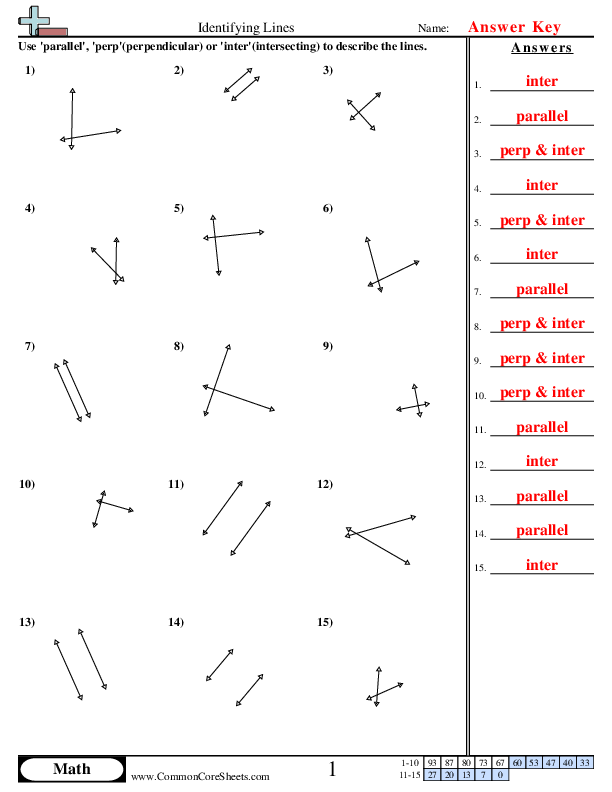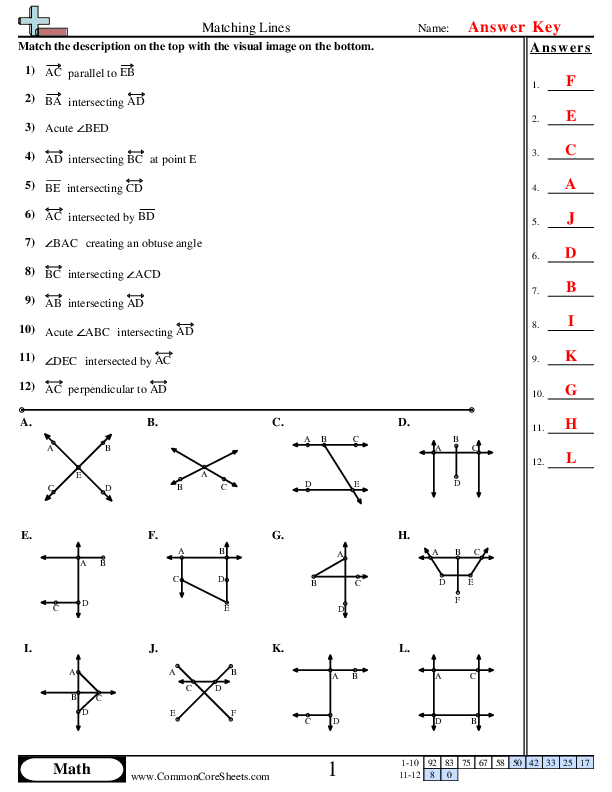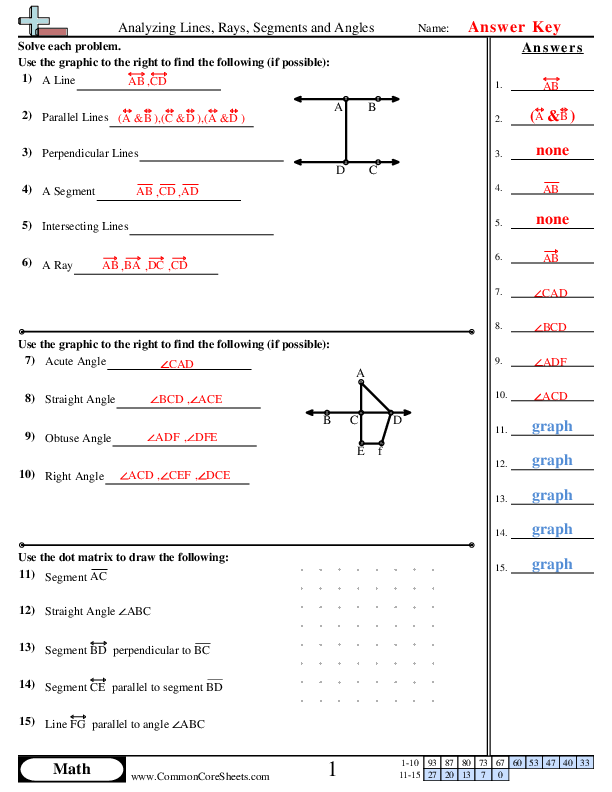Our free lines worksheets are perfect for reinforcing your students' understanding of parallel and perpendicular lines. These lines worksheets feature a variety of activities, including identifying and labeling lines, drawing lines to match given angles, and finding the slope of lines. With plenty of practice problems to choose from, our lines worksheets are the perfect resource for students of all ages. So why wait? Start strengthening your students' lines skills today with our free and comprehensive lines worksheets.
Browse Sheets By Problem Type
×

Perpendicular, Parallel & Intersecting
4g1


×
Description:
"This worksheet is designed to enhance children's mathematical skills in identifying lines. Consisting of 15 customizable problems, it can be easily converted into flashcards or utilized for distance learning. It provides a hands-on approach for students to explore and understand the basic geometric concept of lines, aiding in their cognitive development in the field of math."

×
Student Goals:
Enhancing Analytical SkillsBy successfully completing the worksheet, students are expected to have developed their analytical skills. They should be able to interpret and solve problems more rapidly and effectively as they identify lines in various exercises, demonstrating a solid understanding of concepts taught in math classes.Increased Accuracy in IdentificationOne of the main accomplishments of this worksheet is the ability to accurately identify straight, curved, and zigzag lines in various graphical situations which could be seen in architecture, engineering, and art. This precision is a stepping stone to higher-level math concepts.Grasping Mathematics FoundationMathematics is highly contextual and procedural. This worksheet should help students to secure these basic concepts, and reinforce the foundation of their math knowledge. Being able to identify lines, an essential aspect of geometry, is a critical skill that acts as a building block for future more complicated concepts.Applying Knowledge in Real World ContextAfter finishing the worksheet, pupils should have gained the ability to apply learned knowledge in real-world situations. Lines are not only mathematical concepts, but are also omnipresent in our everyday life. Understanding them theoretically means students should now be able to recognize and make use of this knowledge practically.Boosting Problem-Solving SkillsProblem-solving is a universal skill that is honed by practice. By working through various examples and exercises in the worksheet, students should be better at problem-solving, not only in mathematics but in varied academic and life situations. The mental flexibility gained will support them in independently overcoming obstacles.Enhancing focus and patienceCompleting the worksheet requires attention to detail and patience. This exercise should have allowed students to practice these skills further, leading to an improvement in levels of concentration and patience when tackling similar tasks, which can be applied across different areas of study and beyond academic setting.



Matching Lines


×
Description:
"This worksheet is designed to enhance children's understanding of fundamental concepts of math - specifically intersecting, parallel, and perpendicular lines. The 'Matching Lines' worksheet consists of 12 problems, each exemplifying different scenarios of line interactions, midpoint identification, as well as angle creation. Adaptable in format, this worksheet can be customized to better suit individual needs, converted into interactive flashcards, or used effectively for distance learning, encouraging continuous exploration of mathematical concepts."

×
Student Goals:
Conceptual UnderstandingAfter completing the worksheet, the children should have deepened their understanding of basic geometric concepts such as intersecting and perpendicular lines. They should be comfortable with recognizing these formations within a variety of problems, demonstrating a fundamental comprehension of different line relationships. This foundational knowledge forms a stepping-stone for higher-level geometry studies.Analytical SkillsA successful completion of the worksheet will have students sharpening their analytical and problem-solving skills. They will have to analyze the given problems, visualize the geometrical formations, and apply the correct mathematical concepts. These sharpened analytical skills can be carried over to more complex math problems and other areas of study.Critical ThinkingBy figuring out the answers to these problems, learners are indirectly honing their critical thinking skills. They have to examine the information presented, process it, and make connections between different elements in order to find the correct answers. This exercise strengthens the learner's ability to think critically and logically, skills which are essential for a multitude of academic and life scenarios.Spatial VisualisationAfter working through this set of exercises, students will have enhanced their spatial visualization capabilities. Visualizing spatial relationships is an essential part of geometry, and practicing this skill will help them in future geometry work, as well as in other fields requiring spatial reasoning such as engineering, architecture, or graphic design.Confidence BuildingFinally, successfully navigating through these problems will provide a boost in math confidence. By seeing their ability to understand and solve these geometry problems, students will believe in their ability to tackle more complex mathematical problems and concepts. This self-assuredness will assist learners in future educational ventures and encourage a positive outlook towards math and problem-solving overall.



Analyzing Lines, Rays, Segments and Angles


×
Description:
"This worksheet is designed to enrich children's understanding of lines, rays, segments, and angles concepts in math. Comprising of 15 problems, it explores intersecting and parallel lines, line segment AD, perpendicular lines, and various angles. Ideal for distance learning, the versatile material can be customized or converted into flash cards for enhanced interactivity and learning flexibility."

×
Student Goals:
Understanding Geometric ElementsUpon completion of the worksheet, students should have a robust understanding of basic geometric elements such as lines, rays, segments, and angles. They will be able to distinctly distinguish between these elements and correctly label them in any given geometric configuration.Learning Mathematical TerminologiesThe worksheet provides an excellent opportunity to familiarize students with common mathematical terminologies. After its completion, they should be able to decode various terms associated with geometry like perpendicular, intersecting, parallel, acute, obtuse, and straight angles, as well as conclusively employ them within appropriate contexts.Applying Geometry PrinciplesThrough practicing the problems in the worksheet, the learners will get hands-on experience in applying basic geometric principles. They will be able to demonstrate proficiency in recognizing when and where to apply these principles in geometric scenarios which will be a significant step towards problem-solving proficiency in geometry.Boosting Logical SkillsSolving mathematical puzzles like the ones in the worksheet sharpens the student's logical skills. The sheet’s aim is to help them in interpreting and analyzing geometric problems better and logically deciding on the solution paths which equip them with necessary qualitative aptitude skills.Building Visualization SkillsSolidifying the students' visualization capacity is another accomplishment the worksheet strives for. By grappling with the various geometry problems, the students' ability to visualize geometric entities and their relations would be honed. This visual dexterity is a crucial competence to have for any mathematical and scientific learning.Increasing Geometric FluencyThe consistent exposure to a variety of problems dealing with lines, rays, segments, and angles in the worksheet will help develop students' geometric fluency. After fully completing the tasks, they should be able to comfortably and speedily approach similar problems, indicating an increased level of comfort and fluency in the language of geometry.Reinforcing Mathematical FoundationGiven that the understanding of lines, rays, segments, and angles is fundamental to more complicated geometric and algebraic concepts, completing this worksheet will reinforce the students' foundational mathematical knowledge. This reinforcement forms a strong base for advanced learning and aids in overall academic achievement in math.




